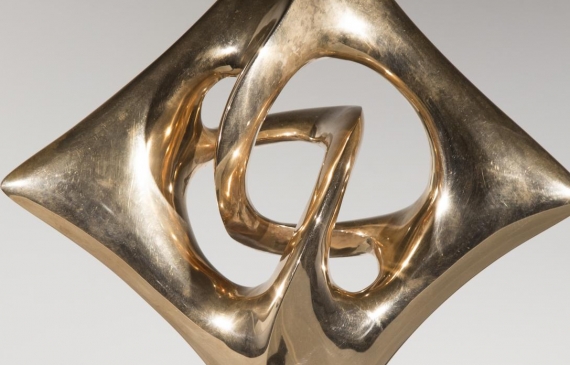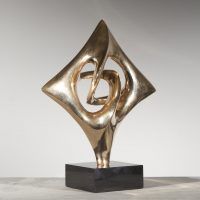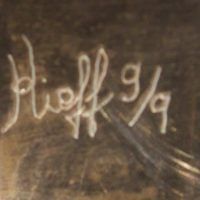


Antonio Grediaga Kieff
Canadian-Spanish, b. 1936
Folkloric Fado
Bronze mounted on a black marble pedestal
12 ⅝ H. x 12 W. x 4 ¾ D. inches
Signed and numbered: Kieff 9/9
A sculptor, painter, graphic artist, draftsman, muralist, printmaker, jewelry maker and educator, Kieff Antonio Grediaga (also known as Antonio Grediaga Kieff) was born in Madrid, Spain and has lived in Montreal and Saint Bruno, Quebec, Canada since 1969. Grediaga is mostly a self taught artist. However, before coming to Canada, he studied industrial design, engineering, architecture, drama and music (operatic singing). He is best known for his table-top bronzes and monumental public space sculptures.
His mediums include bronze, aluminum, steel, wood, iron, marble, granite, commemorative medals, acrylic, oil, gouache, tempera, fresco, pastel, collage, found objects, etching, gold, gemstones, installations, and mixed mediums. Most of his work is abstract, therefore the primary subjects are shape, color and texture. However, the bullfighting fan appears frequently in various mediums and his other subjects include busts, figures, nudes, dancers, still lifes, symbolism, allegory, and architectural studies. His styles include Abstract Expressionism, Biomorphism, Color Field Painting, Concrete Art, Constructivism, Cubism, Fauvism, Kinetic Art, and Surrealism.
His works have been exhibited in the Mann Auditorium, Tel Aviv, Israel; the National Gallery, Taipei, Taiwan; the Chiang Kai-Shek Museum, Kaohsiung, Taiwan; the Centre d’Art Ozias Leduc, St. Hilaire, Quebec; the Cultural Centre of Spain, Havana; the Emilio Bacardi Moreau Museum, Santiago de Cuba; the National Museum of Fine Arts, Havana, Cuba; and the Museum of the City, Madrid.
Grediaga has also exhibited at numerous prominent commercial galleries in Montreal, across North America, and around the world, such as Gallery Moos, Montreal; Dominion Gallery, Montreal; Galerie Bernard Desroches, Montreal; Wallack Galleries, Ottawa; David Findlay Galleries, New York; Martin Lawrence Gallery, New York; Pucker Safrai Gallery, Boston; Kenmore Galleries, Philadelphia; Hokin Gallery, Chicago; Virginia Miller Gallery, Miami; Klabal Gallery, Minneapolis; Dubose Gallery, Houston; Maxwell Gallery, San Francisco; Ross Lawrence Gallery, Beverly Hills; Alwin Gallery, London, England; O’Hana Gallery, London, England; Safrai Gallery, Tel Aviv, Israel; and Minami Gallery, Tokyo, Japan.
The titles and locations of some of his public space works are:
Bullfighting Fan (iron), Plaza Vieja, Havana, Cuba
Reclining Woman (bronze), Southfield, Michigan
The Three Graces (bronze), Southfield, Michigan
Je me souviens (20 x 12 mural), Cultural Center, Saint Bruno, Quebec
Folk Allegory (bronze), Cultural Center, Saint Bruno, Quebec
Totem (bronze) city hall, Saint Bruno, Quebec
Totem 86 (bronze), Crescent Street, Montreal
The Turning Point (iron and aluminum), Columbus Circle, New York City [outdoor kinetic installation at the International Art Expo, 1980]
Folklore no. 22 (bronze), Weight Watchers Corporation, Minneapolis, Minnesota Folklore no. 22 A (bronze), The Paragon Group, Dallas, Texas
Genesis XI (bronze), Blossom Music Center, Cleveland, Ohio